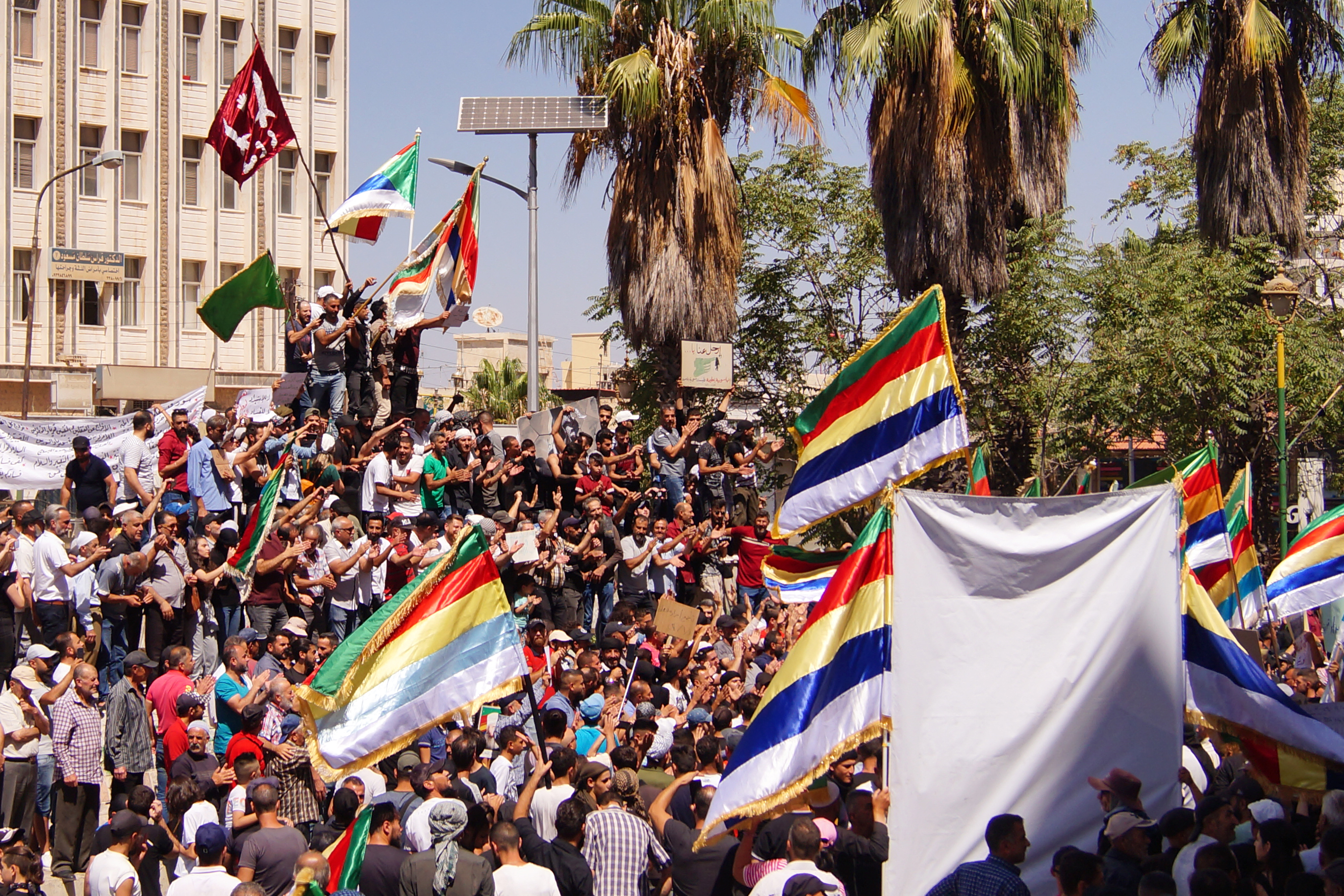As protests in the southern Syrian province of Sweida enter a fifth week, the number of demonstrators has swelled to the thousands, a stunning turnout for the majority-Druze region.
The demonstrations initially began as an outcry against a cut in fuel subsidies but have rapidly transformed into a broader political movement, with protesters demanding the fall of President Bashar Al Assad’s government.
The regime has refrained from using an iron fist in Sweida unlike in 2011 when Assad’s brutal crackdown on Arab Spring protests snowballed into more than a decade of conflict. Instead, given Sweida’s well-armed population and large Druze demographic, it has adopted a strategy of heightened violence in other areas to prevent the protests from spreading out of control.
Alongside the arrests of dissenting voices, military and security forces have imposed blockades on former rebel-held zones in Aleppo and rural Damascus. These aggressive measures help explain the near absence of demonstrations in other regions, despite widespread anger over the deteriorating economic situation.
While Sweida has remained under regime control throughout the country’s 12-year civil war, local armed groups have emerged to protect their communities from threats, including those posed by the regime. Sweida’s local communities are not only well-armed but also bound by strong social and religious ties. Historically, these bonds have proven instrumental in swiftly resolving differences and rallying against external foes.
With no apparent concessions to offer Sweida’s protestors, there are growing concerns that Syrian security forces might resort to a crackdown. In fact, on September 13, three people were wounded when shots were fired at protesters, according to activists and local journalists. Exactly who shot at the protesters has yet to be confirmed, but the violence did not stop an estimated 3,500 to 4,000 people from protesting on September 15.
The regime is fully aware that the use of force to suppress protests carries the risk of transforming peaceful demonstrations into a widespread armed resistance movement, potentially extending beyond the province. Despite their symbolic importance in undermining his authority, Sweida’s protests don’t currently threaten Assad’s survival. This is partly due to their peaceful nature and the remote location of the province.
Hence, instead of opting for escalation, the regime seems to be implementing a long-term strategy. Damascus has significantly reduced government services, adding considerable challenges to the daily lives of residents. The hope, to the regime, is that the increased burden will eventually lead to fatigue or division, potentially quelling the protests.
Meanwhile, the regime seems to have shifted its primary focus toward containing the protests within Sweida. In pursuit of this goal, military forces and security agencies have built blockades in several localities in the Damascus countryside. These areas, near Sweida, have a history of rebellion. Hence, the regime aimed to preemptively quell any opposing movements by encircling cities and towns where protests are anticipated.
This tactic was initially observed on August 24 in Wadi Barada, where several villages, including Deir Qanoun, Deir Maqran, Kfeir Al Zayt, Souq Wadi Barada, Al Husseiniya, and Burhelia, faced these measures just one day after calls for civil disobedience and a general strike. The regime deployed military reinforcements, including heavy machine guns, artillery, and tanks and threatened to storm the villages, using the presence of ISIS cells as a pretext.
In a pattern that has become all too familiar, the regime has used a carrot-and-stick approach. Individuals wanted by the regime were given the option of participating in a “reconciliation” process, also known as settlements, in exchange for refraining from escalating actions against them or their towns. This same strategy, encompassing both coercive and conciliatory measures, was subsequently applied to varying degrees in other areas, including Kanakir, Zakia, and Babila. The specific terms of these “reconciliations” varies from one area to another, but all served the goal of enhancing regime control over areas classified as “hot” or “unsafe” to prevent the spread of protests. Security forces have also intensified patrols and set up checkpoints in other cities surrounding the capital, such as Yalda and Qudsaya, in response to the distribution of anti-regime pamphlets.
Likewise, the regime is reportedly working to establish a security cordon by deploying checkpoints around eastern Aleppo, in the country’s north. This region, which fiercely opposed the regime at the height of the civil war, has recently witnessed protests against Assad. This has raised concerns about the potential resurgence of conflict in the area. In response, security branches in the city have been reportedly instructed to mobilize militias to address this situation. Over 100 people in Aleppo were also reportedly arrested on charges related to involvement in demonstrations or criticism of the regime.
In the provinces of Latakia and Tartus, calls for demonstrations have reportedly increased the regime’s security presence on the streets. The regime is also alleged to have detained around 70 individuals to date to prevent any protests in areas considered regime strongholds.
It remains to be seen if the regime’s tailored approach will enable it to weather the ongoing wave of protests. However, the current situation underscores a critical point: Despite immense suffering endured by Syrians throughout the civil war, their losses are unlikely to deter them from demonstrating once more if they cannot provide for their families. Until substantial change is implemented, new waves of unrest are likely to persist.
Dr. Haid Haid is a Syrian columnist and a consulting associate fellow of Chatham House’s Middle East and North Africa program. X: @HaidHaid22

